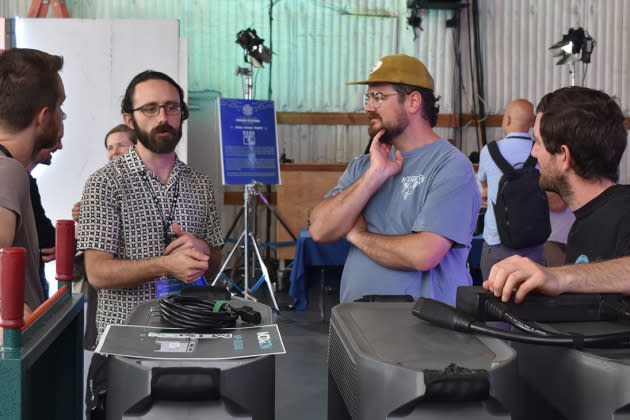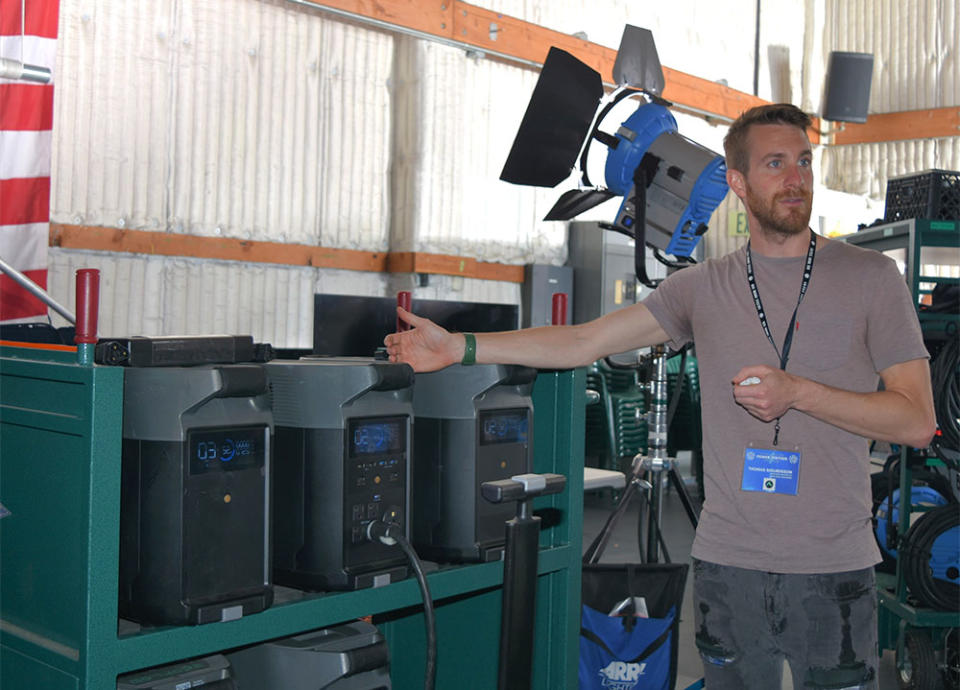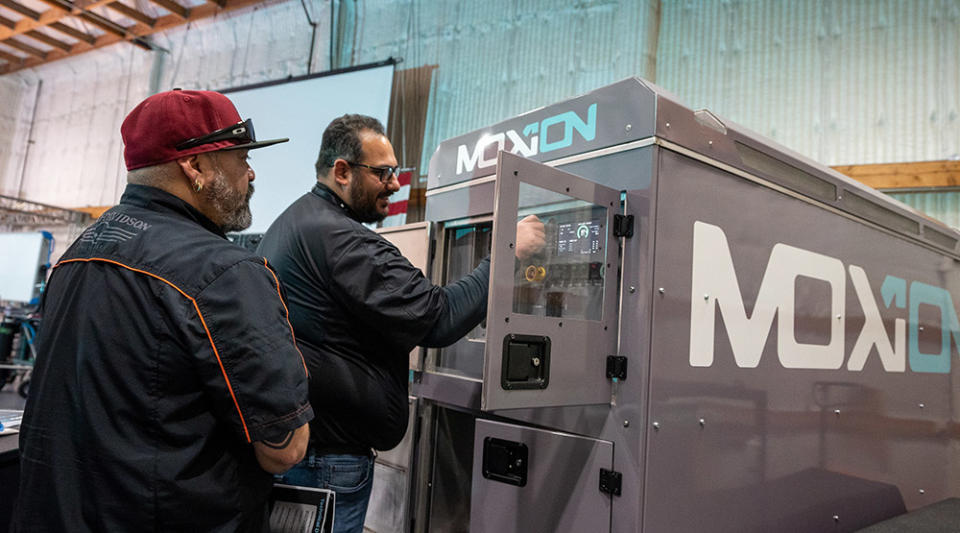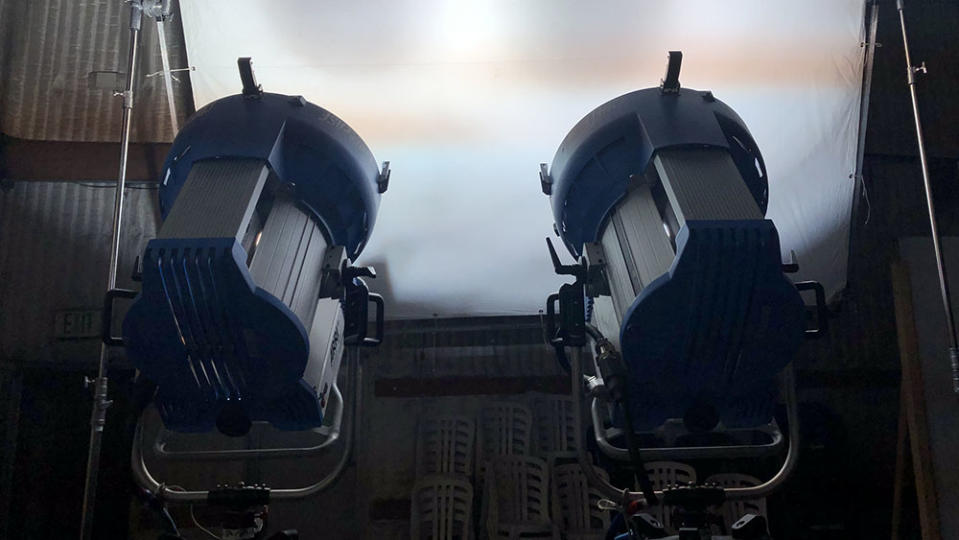Can Film and TV Sets Cut Down On Emissions? A Few Ideas Are Being Pushed By Crews
- Oops!Something went wrong.Please try again later.

Jason Fitzgerald was standing in front of a boxy e-generator the size of a small trailer, recalling how the technology helped enable a tricky scene on an upcoming Christmas movie starring The Rock.
The veteran rigging gaffer (The Morning Show, You People) had recently worked on Amazon Studios’ Red One, which sees Dwayne Johnson on a mission to save Santa Claus. During a scene shot at a busy shopping mall in Atlanta, Georgia, production needed to power a light-heavy Santa’s Workshop-type setup but couldn’t run long cables to the building’s exterior to do so, recalled Fitzgerald. So, the production discreetly built a Voltstack electric generator into the scene so to quietly power an array of Christmas lights, decorations, animatronics and even a small train without obtrusive cables.
More from The Hollywood Reporter
Writers Authorize Strike: Nearly 98 Percent Support Work Stoppage
Donald Trump Quit SAG-AFTRA Two Years Ago -- But Still Collects 6-Figure Pension
Judge Dismisses Garth Drabinsky Defamation Suit Against Actors' Equity
“We’ve used them in churches, you can take them into parking garages, you can put them on skids and take them down into tunnels,” Fitzgerald said of these kinds of power stations. “No emissions, no sound, no exhaust.” He added, “It is the future.”
Fitzgerald was one of several members of IATSE Local 728 that were exhibiting sustainable power solutions for film and television sets on Sunday — and also explaining how they themselves have used the technology on high-stakes productions. The showcase, organized by the union’s Eco Committee, exhibited portable power stations, an electric camera car and large zero-emission batteries from companies including Moxion Power, Grip Trix, FlashFish and Goal Zero at IATSE Local 80’s headquarters in Burbank. The goal: Help members of the labor group — which represents electrical lighting technicians — learn how to use cleaner power sources in the regular course of their work and encourage them to advocate for their use on set at a time when, despite the efforts of some studio sustainability programs, emission-spewing diesel generators remain the industry standard.
A 2021 report by the Sustainable Production Alliance, which counts major Hollywood studios and streamers as members, found that fuel use from transportation and power sources like diesel generators was the largest contributing factor to carbon emissions on feature films, one-hour scripted dramas and single-camera series: 48 percent of a tentpole film’s average carbon footprint (3,370 metric tons), for instance, came from fuel use. A study produced one year earlier by the British Film Institute and the Albert consortium found that the use of diesel generators specifically accounted for 15 percent of total carbon emissions on the set of an average tentpole film.

“It’s things that we’re breathing, it’s things that the neighborhood is breathing, it’s immediate impact on the environment,” said lighting technician Max Schwartz (Nope, Insecure), an organizer of Sunday’s event, of the emissions produced by diesel and gasoline generators. “We can discuss the emissions of lithium farming and its detriment, but the reality is also that we are offsetting the immediate effects of gasoline and diesel generators by using these [more sustainable power source] products.”
The impetus for the event emerged from individual Eco Committee members’ previously unsuccessful attempts to bring alternative power sources to set, said Schwartz. While sustainability programs at producers like Amazon Studios and HBO have been taking steps to wean productions off of diesel generators, at large “We’ve met with the same problem, set after set after set, which is that we can request it and the production can want it, but if the funds don’t exist to support it because it is more costly than your average diesel generator, then it can’t be made on,” said Schwartz.
With initiatives like Sunday’s event, the union’s Eco Committee is seeking to further condition the industry to the technology and to encourage more crew members to request these kinds of devices. “I think it definitely has to come with individuals requesting this equipment on a consistent basis so the names are in [studios’] minds and they’re actually like ‘Okay, cool, this is reliable, everybody’s requesting it,’ ” said lighting programmer and Local 728 Eco Committee member Iván Herrera (Kimi, Waffle + Mochi’s Restaurant).
One important threshold that lighting technicians would want to see a power source meet, organizers explain, is sustaining an 18K HMI light and at least one other light over the course of a 10 to 12-hour day. During the event, one Moxion 600 kilowatt hour mobile power station was facilitating the use of three 18K lights at once, to demonstrate this capability — and could power them for nine hours, according to Moxion senior manager of strategy and partnerships Cynthia Leung.
But smaller-range devices can have their uses, too. Fixture technician Jonathan Barrera (The Mandalorian), who was demonstrating how compact power stations can light up LED ribbons, lauds their “portability and accessibility.” Using a Jackery Explorer 500 or Goal Zero Yeti 1000X, Barrera said, he can test lights without relying on a generator, thereby cutting down on a production’s carbon footprint. He also notes that these devices can be used for scenes that require mobile and/or hidden lights, recalling how a Jackery device “saved our butt” during a chase sequence on Disney+’s Obi-Wan Kenobi involving Princess Leia running through a city tinged with neon lights. “You don’t want to see cables, you don’t want to see power supplies, so this is perfect. I can hide this,” he said.

Beyond their environmental benefits, several attendees at the event noted that quieter power stations can help improve relationships with neighborhoods when film and TV productions are on location. “Here we are, blasting loud generators late at night because we want to shoot a film in some period-accurate location,” said Schwartz. “Having these generators are perfectly quiet. Not only that, but since they are quiet, you can have them right next to set, which means less cable run, less square footage of a neighborhood that you’re taking up.”
Organizers believe that the time to begin incorporating this emerging technology onto film sets at large is now, even if these innovations aren’t perfect. With California setting a goal to reach carbon neutrality by 2045, “it seems like, even outside of our own desire to push this technology, that it will become an inevitability,” said Schwartz. And Sony Group has implemented its own climate plan, with the goal of having “zero environmental footprint” by 2050, Sony vp sustainability John Rego told THR in March.
Beyond helping the industry to meet internal and state targets, rigging gaffer Fitzgerald believes film and TV professionals at all levels need to also take it upon themselves to incorporate these more sustainable power solutions. “I’ve made a living in this business for over 30 years, a really good living,” he said. “And I think it’s all of our responsibility to make sure that what we’re doing is not doing damage that’s irreversible.”

Best of The Hollywood Reporter
Meet the World Builders: Hollywood's Top Physical Production Executives of 2023
Men in Blazers, Hollywood’s Favorite Soccer Podcast, Aims for a Global Empire

